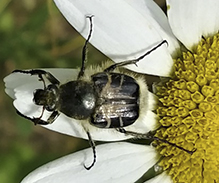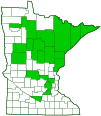bee-mimic beetle
(Trichiotinus assimilis)
Conservation • Description • Habitat • Ecology • Distribution • Taxonomy
Conservation Status |
|
|||||||
| IUCN Red List | not listed |
|||||||
| NatureServe | not listed |
|||||||
| Minnesota | not listed |
|||||||
Description |
||
Bee-mimic beetle is a hairy, stout-bodied, oval, ¼″ to ½″ long, flower chafer beetle. The body is more or less flattened above. The upper plate covering the thorax (pronotum) is brown to black and densely covered with long, tan hairs. The hardened outer wings (elytra) are black with brown and pale markings. Two brown or whitish longitudinal stripes near the inner margin of each elytra join in an irregular brown patch near the forward margin. Two pale brown or whitish horizontal stripes extend from the outermost longitudinal stripe to the outer margin of each elytra. The horizontal stripes are unusual and help to identify this as belonging to the tribe Trichiini. The abdomen is densely covered with long hairs that poke out from under the elytra. Each antenna has 3 long projections on one side that can be brought together and closed tightly. The first segment of the front leg (coxa) is conical. The pair of claws at the end of each hind foot (tarsus) is simple, not doubled or toothed, and are of equal length. |
||
Size |
||
¼″ to ½″ |
||
Similar Species |
||
Habitat |
||
Open areas near woodlands |
||
Ecology |
||
Season |
||
April to August |
||
Behavior |
||
|
||
Life Cycle |
||
The female lays her eggs in rotting wood of decaying hardwood trees. |
||
Larva Food |
||
Rotting wood |
||
Adult Food |
||
Slower pollen and/or nectar. May also feed on foliage and stems. |
||
Distribution |
||||
|
Sources |
|||
| 7/12/2022 | ||||
Occurrence |
||||
Common |
||||
Taxonomy |
|||
Order |
Coleoptera (Beetles) | ||
Suborder |
Polyphaga (Water, Rove, Scarab, Long-horned, Leaf, and Snout Beetles) | ||
Infraorder |
Scarabaeiformia | ||
Superfamily |
Scarabaeoidea (Scarabs, Stag Beetles, and Allies) | ||
Family |
Scarabaeidae (scarabs) | ||
Subfamily |
Cetoniinae (fruit and flower chafers) | ||
Tribe |
Trichiini (bee beetles and flower scarabs) | ||
Subtribe |
Trichiina | ||
Genus |
Trichiotinus (bee-like flower scarabs) | ||
Synonyms |
|||
Trichius bistriga |
|||
Common Names |
|||
bee-mimic beetle |
|||
Glossary
Elytra
The hardened or leathery forewings of beetles used to protect the fragile hindwings, which are used for flying. Singular: elytron.
Pronotum
The exoskeletal plate on the upper side of the first segment of the thorax of an insect.
Tarsus
On insects, the last two to five subdivisions of the leg, attached to the tibia; the foot. On spiders, the last segment of the leg. Plural: tarsi.
Visitor Photos |
|||||
Share your photo of this insect. |
|||||
| This button not working for you? Simply email us at info@MinnesotaSeasons.com. Attach one or more photos and, if you like, a caption. |
|||||
Luciearl |
|||||
 |
|||||
Bill Reynolds |
|||||
| While hunting on Prairie Rose this White Crab Spider turned up it's nose, so to speak, and walked away from the Carrion Beetle. I guess it pays to stink a little. |
 |
||||
MinnesotaSeasons.com Photos |
|||||
|
|||||

Slideshows |
||

Visitor Videos |
|||
Share your video of this insect. |
|||
| This button not working for you? Simply email us at info@MinnesotaSeasons.com. Attach a video, a YouTube link, or a cloud storage link. |
|||
Other Videos |
|||
| Scarabée des marguerites/Flower Beetle (Trichiotinus assimilis) Dominique Lalonde Films Nature |
|||
About
Oct 28, 2021 Découvrez les insectes du Québec. Discover the insects of Quebec. Abonnez-vous pour ne rien manquer !/Subscribe to miss nothing ! https://www.youtube.com/user/Explorationnature |
|||


Created: 9/6/2015
Last Updated:


